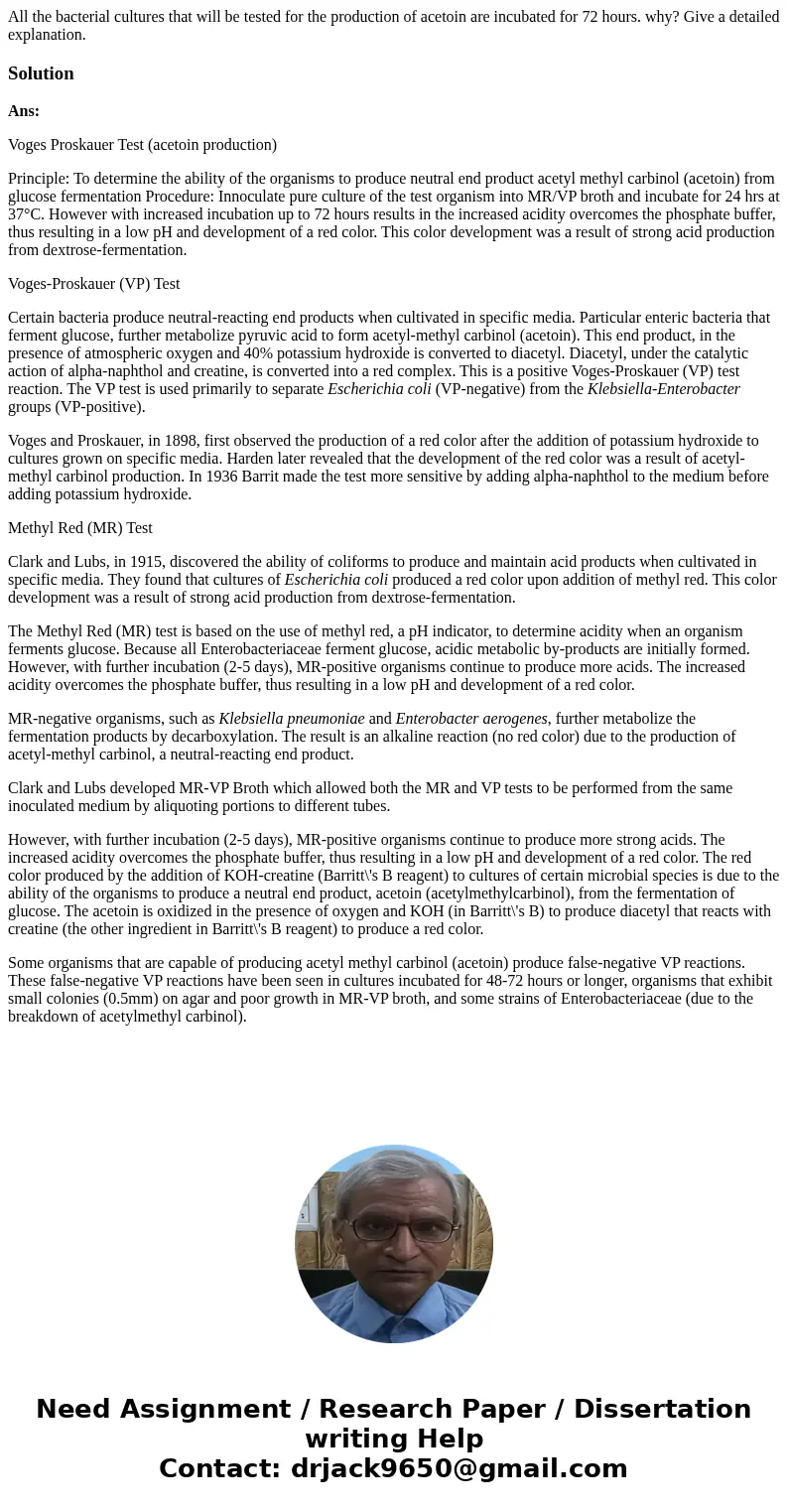All the bacterial cultures that will be tested for the produ
All the bacterial cultures that will be tested for the production of acetoin are incubated for 72 hours. why? Give a detailed explanation.
Solution
Ans:
Voges Proskauer Test (acetoin production)
Principle: To determine the ability of the organisms to produce neutral end product acetyl methyl carbinol (acetoin) from glucose fermentation Procedure: Innoculate pure culture of the test organism into MR/VP broth and incubate for 24 hrs at 37°C. However with increased incubation up to 72 hours results in the increased acidity overcomes the phosphate buffer, thus resulting in a low pH and development of a red color. This color development was a result of strong acid production from dextrose-fermentation.
Voges-Proskauer (VP) Test
Certain bacteria produce neutral-reacting end products when cultivated in specific media. Particular enteric bacteria that ferment glucose, further metabolize pyruvic acid to form acetyl-methyl carbinol (acetoin). This end product, in the presence of atmospheric oxygen and 40% potassium hydroxide is converted to diacetyl. Diacetyl, under the catalytic action of alpha-naphthol and creatine, is converted into a red complex. This is a positive Voges-Proskauer (VP) test reaction. The VP test is used primarily to separate Escherichia coli (VP-negative) from the Klebsiella-Enterobacter groups (VP-positive).
Voges and Proskauer, in 1898, first observed the production of a red color after the addition of potassium hydroxide to cultures grown on specific media. Harden later revealed that the development of the red color was a result of acetyl-methyl carbinol production. In 1936 Barrit made the test more sensitive by adding alpha-naphthol to the medium before adding potassium hydroxide.
Methyl Red (MR) Test
Clark and Lubs, in 1915, discovered the ability of coliforms to produce and maintain acid products when cultivated in specific media. They found that cultures of Escherichia coli produced a red color upon addition of methyl red. This color development was a result of strong acid production from dextrose-fermentation.
The Methyl Red (MR) test is based on the use of methyl red, a pH indicator, to determine acidity when an organism ferments glucose. Because all Enterobacteriaceae ferment glucose, acidic metabolic by-products are initially formed. However, with further incubation (2-5 days), MR-positive organisms continue to produce more acids. The increased acidity overcomes the phosphate buffer, thus resulting in a low pH and development of a red color.
MR-negative organisms, such as Klebsiella pneumoniae and Enterobacter aerogenes, further metabolize the fermentation products by decarboxylation. The result is an alkaline reaction (no red color) due to the production of acetyl-methyl carbinol, a neutral-reacting end product.
Clark and Lubs developed MR-VP Broth which allowed both the MR and VP tests to be performed from the same inoculated medium by aliquoting portions to different tubes.
However, with further incubation (2-5 days), MR-positive organisms continue to produce more strong acids. The increased acidity overcomes the phosphate buffer, thus resulting in a low pH and development of a red color. The red color produced by the addition of KOH-creatine (Barritt\'s B reagent) to cultures of certain microbial species is due to the ability of the organisms to produce a neutral end product, acetoin (acetylmethylcarbinol), from the fermentation of glucose. The acetoin is oxidized in the presence of oxygen and KOH (in Barritt\'s B) to produce diacetyl that reacts with creatine (the other ingredient in Barritt\'s B reagent) to produce a red color.
Some organisms that are capable of producing acetyl methyl carbinol (acetoin) produce false-negative VP reactions. These false-negative VP reactions have been seen in cultures incubated for 48-72 hours or longer, organisms that exhibit small colonies (0.5mm) on agar and poor growth in MR-VP broth, and some strains of Enterobacteriaceae (due to the breakdown of acetylmethyl carbinol).

 Homework Sourse
Homework Sourse